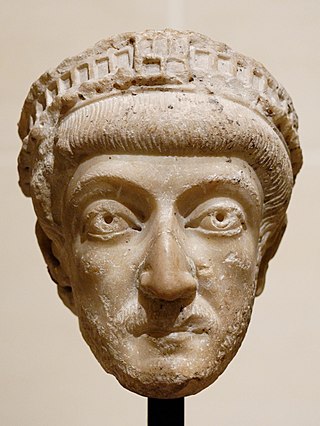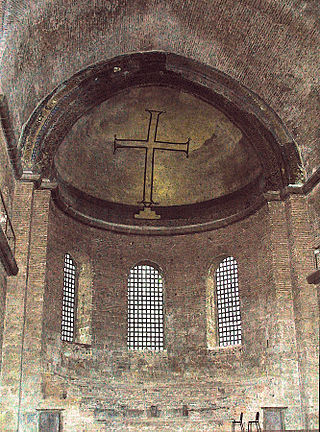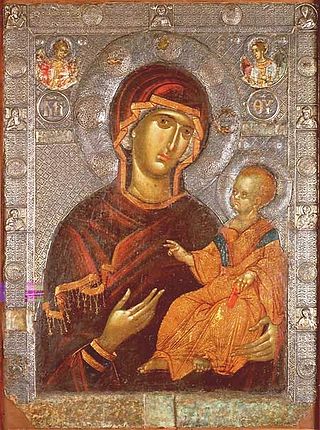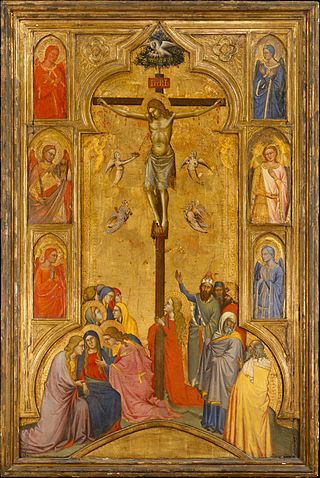
Liz James is a British art historian who studies the art of the Byzantine Empire. She is Professor of the History of Art at the University of Sussex. [1]

Liz James is a British art historian who studies the art of the Byzantine Empire. She is Professor of the History of Art at the University of Sussex. [1]
James is originally from Derby, East Midlands. She received an undergraduate degree at the University of Durham in Ancient History and Archaeology. She completed a master's degree in Byzantine studies at the University of Birmingham. She received her doctorate at the Courtauld Institute in London in 1989, studying under Robin Cormack. Her thesis discussed light and colour in Byzantine art and was entitled Colour Perception in Byzantium. [2] Upon completion, she embarked on postdoctoral fellowships, notably at the Barber Institute. In 1993 she joined the University of Sussex. [3]
James was appointed Professor in 2007. Her professorial lecture was given in 2011 and discussed the mosaics in the apse of Hagia Sophia. [4]
James is known as a keen promoter of all areas of Byzantine art and Byzantine culture. She has particular interests in mosaics and in gender issues. She has written extensively on mosaics, discussing practical, iconographic and materialistic approaches to the subject. She has also established a database of Byzantine glass mosaics. [5] In the field of gender, she has discussed Byzantine empresses, eunuchs and the way Byzantine society reacted to gender. She is also interested in the relationship between text and image, believing Byzantine texts to be of equal importance to Byzantine art. James contributed to the Royal Academy's 2008 Byzantium exhibition catalogue and gave a lecture to the academy. [6]

Theodosius II was Roman emperor from 402 to 450. He was proclaimed augustus as an infant and ruled as the Eastern Empire's sole emperor after the death of his father, Arcadius, in 408. His reign was marked by the promulgation of the Theodosian law code and the construction of the Theodosian Walls of Constantinople. He also presided over the outbreak of two great Christological controversies, Nestorianism and Eutychianism.

Daphni or Dafni is an eleventh-century Byzantine monastery eleven kilometers northwest of central Athens in the suburb of Chaidari, south of Athinon Avenue (GR-8A). It is situated near the forest of the same name, on the Sacred Way that led to Eleusis. The forest covers about 18 km2 (7 sq mi), and surrounds a laurel grove. "Daphni" is the modern Greek name that means "laurel grove", derived from Daphneion (Lauretum).
Byzantine art comprises the body of artistic products of the Eastern Roman Empire, as well as the nations and states that inherited culturally from the empire. Though the empire itself emerged from the decline of western Rome and lasted until the Fall of Constantinople in 1453, the start date of the Byzantine period is rather clearer in art history than in political history, if still imprecise. Many Eastern Orthodox states in Eastern Europe, as well as to some degree the Islamic states of the eastern Mediterranean, preserved many aspects of the empire's culture and art for centuries afterward.
Elizabeth Mary Jeffreys was a British scholar of Byzantium. She was Bywater and Sotheby Professor of Byzantine and Modern Greek Language and Literature, University of Oxford, and a Professorial Fellow of Exeter College, Oxford, 1996–2006.

The Byzantine Iconoclasm were two periods in the history of the Byzantine Empire when the use of religious images or icons was opposed by religious and imperial authorities within the Ecumenical Patriarchate and the temporal imperial hierarchy. The First Iconoclasm, as it is sometimes called, occurred between about 726 and 787, while the Second Iconoclasm occurred between 814 and 842. According to the traditional view, Byzantine Iconoclasm was started by a ban on religious images promulgated by the Byzantine Emperor Leo III the Isaurian, and continued under his successors. It was accompanied by widespread destruction of religious images and persecution of supporters of the veneration of images. The Papacy remained firmly in support of the use of religious images throughout the period, and the whole episode widened the growing divergence between the Byzantine and Carolingian traditions in what was still a unified European Church, as well as facilitating the reduction or removal of Byzantine political control over parts of the Italian Peninsula.

A Hodegetria, or Virgin Hodegetria, is an iconographic depiction of the Theotokos holding the Child Jesus at her side while pointing to him as the source of salvation for humankind. The Virgin's head usually inclines towards the child, who raises his hand in a blessing gesture. Metals are often used to draw attention to young Christ, reflecting light and shining in a way to embody divinity. In the Western Church this type of icon is sometimes called Our Lady of the Way.

Judith Herrin is an English archaeologist, byzantinist, and historian of Late Antiquity. She was a professor of Late Antique and Byzantine sudies and the Constantine Leventis Senior Research Fellow at King's College London.

The Palaeologan Renaissance or Palaiologan Renaissance is the final period in the development of Byzantine art. Coinciding with the reign of the Palaiologoi, the last dynasty to rule the Byzantine Empire (1261–1453), it was an attempt to restore Byzantine self-confidence and cultural prestige after the empire had endured a long period of foreign occupation. The legacy of this era is observable both in Greek culture after the empire's fall and in the Italian Renaissance. Scholars of the time utilized several classical texts.

The Chrysotriklinos, Latinized as Chrysotriclinus or Chrysotriclinium, was the main reception and ceremonial hall of the Great Palace of Constantinople from its construction, in the late 6th century, until the 10th century. Its appearance is known only through literary descriptions, chiefly the 10th-century De Ceremoniis, a collection of imperial ceremonies, but, as the chief symbol of imperial power, it inspired the construction of Charlemagne's Palatine Chapel in Aachen.

Robin Sinclair Cormack, FSA is a British classicist and art historian, specialising in Byzantine art. He was Professor in the History of Art, Courtauld Institute of Art, University of London, 1991–2004.

The Church of Hosios David is a late 5th-century church in Thessaloniki, Greece. During Byzantine times, it functioned as the katholikon of the Latomos Monastery, and was adorned with rich mosaic and fresco decoration, which was renewed in the 12th–14th centuries. The church is dedicated to David the Dendrite. Many surviving elements of the Byzantine decoration are of high artistic quality, especially the 5th-century apse mosaic the Icon of Christ of Latomos. Under Ottoman rule, the building was converted into a mosque, until it was reconsecrated as a Greek Orthodox church in 1921, thus receiving its present name. In 1988, this monument was included among the Paleochristian and Byzantine monuments of Thessaloniki on the list of World Heritage Sites by UNESCO.

The Icon of the Triumph of Orthodoxy is the festal icon for the first Sunday of Great Lent, a celebration that commemorated the end of Byzantine Iconoclasm and restoration of icons to the church in 843, and which remains a church feast in Orthodoxy. It is the earliest known depiction of this subject, and thought to have been painted in Constantinople, capital of the Byzantine Empire. It was purchased by the British Museum in 1988. The dimensions of the icon are: height: 37.8 cm, width: 31.4 cm, depth: 5.3 cm.

Byzantine glass objects resembled their earlier Hellenistic counterparts, during the fourth and early fifth centuries CE in both form and function. Over the course of the fifth century CE, Byzantine glass blowers, based mostly in the area of Syria and Palestine, developed a distinct Byzantine style. While glass vessels continued to serve as the primary vehicles for pouring and drinking liquid, glassware for lighting, currency and commodity weights, window panes, and glass tesserae for mosaics and enamels also surged in popularity.
Leslie Brubaker is an expert in Byzantine illustrated manuscripts. She was appointed Professor of Byzantine Art at the University of Birmingham in 2005, and is now Professor Emerita. Her research interests includes female patronage, icons and the cult of the Virgin Mary. She was formerly the head of Postgraduate Studies in the College of Arts and Law, University of Birmingham. Professor Brubaker is the Chair of the Society for the Promotion of Byzantine Studies. Her work is widely stocked in libraries around the world.

Ruth Iouliani (Juliana) Macrides was a UK-based historian of the Byzantine Empire. At the time of her death, she was Reader in Byzantine Studies at the Centre for Byzantine, Ottoman and Greek Studies at the University of Birmingham. She was an expert in Byzantine history, culture and politics, particularly of the mid-later Byzantine period, and on the reception of Byzantium in Britain and Greece.

The situation of women in the Byzantine Empire is a subject of scientific research that encompasses all available information about women, their environments, their networks, their legal status, etc., in the Byzantine Empire.
Alice-Mary Talbot is an American Byzantinist. She is director of Byzantine studies emerita, Dumbarton Oaks Research Library and Collection.

Gold ground or gold-ground (adjective) is a term in art history for a style of images with all or most of the background in a solid gold colour. Historically, real gold leaf has normally been used, giving a luxurious appearance. The style has been used in several periods and places, but is especially associated with Byzantine and medieval art in mosaic, illuminated manuscripts and panel paintings, where it was for many centuries the dominant style for some types of images, such as icons. For three-dimensional objects, the term is gilded or gold-plated.
Lynda Garland is a scholar and professor at the University of Queensland. Her research focuses on female images in the Late Antiquity period and Byzantine Society.
The Icon of Christ of Latomos, also known as the Miracle of Latomos, is a 5th-century Byzantine mosaic of Jesus in the monastery of Latomos in Thessaloniki, Greece, that is an acheiropoieton. The later legend of this mosaic goes back even earlier, to the late third century AD when Maximian and Diocletian reigned jointly over the Roman Empire. The Icon of Christ of Latomos is one of the lesser-known acheiropoieta.